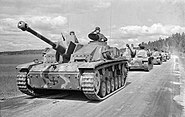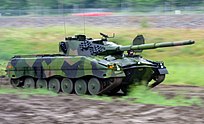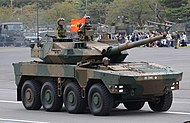Assault gun
This articleneeds additional citations forverification.(January 2013) |
Top right: US WWIIM4A3 (105)assault gun.
Lower left: SwedishCold WarIkv 91assault gun.
Lower right: JapaneseType 16 maneuver combat vehicle(Japanese:16 thức cơ động chiến đấu xe)modern assault gun.
Anassault gun(from‹See Tfd›German:Sturmgeschütz,lit. 'storm gun',meaning "assault gun" )[1]is a type ofself-propelled artillery[2]which uses aninfantry support gunmounted on a motorized chassis, normally anarmored fighting vehicle,[3]which are designed to providedirect firesupport forinfantryattacks, especially against other infantry orfortifiedpositions.[1]Assault guns were pioneered by theSoviet UnionandNazi Germanyduring the 1930s, initially being self-propelled guns with direct fire in mind (such as the SovietSU-5-1), with Germany introducing the first purpose-built (and purpose-named) assault gun, theSturmgeschütz III,in 1940.[1]
Historically, the concept of assault guns was very similar to that of theinfantry tank,as both were combat vehicles intended to accompany infantry formations into battle.[4]However, duringWorld War IIassault guns were more mobile than tanks and could be utilized as both direct andindirect fireartillery.[4]Although they could approximate the firepower of a tank, assault guns mostly firedhigh explosive shellsat relatively low velocities, which were well suited for their role of knocking out hard points such as fortified positions and buildings.[4]They were not intended to be deployed as tank substitutes or dedicatedtank destroyers.[4]Nevertheless, as the conflict progressed, the increasing proliferation of tanks on the battlefield forced many assault gun units to engage armor in defense of the infantry, and led to armies becoming more dependent on multipurpose designs which combined the traditionally separate roles of an assault gun and a tank destroyer.[5]
German and Soviet assault guns introduced during World War II usually carried their main armament in a fully enclosedcasematerather than agun turret.[6]Although this limited thefield of fireand traverse of the armament, it also had the advantage of a reduced silhouette and simplified the manufacturing process.[6]The United States never developed a purpose-built assault gun during the war, although it did modify preexisting armored fighting vehicles for that role, including theM4 Sherman(as the M4(105)), theM5 Stuart(as theM8 Scott), and theM3 half-track(as theT19 Howitzer Motor Carriage).[7]The classic assault gun concept was largely abandoned during the postwar era in favor of tanks or multipurpose tank destroyers attached to infantry formations, which were also capable of providing direct fire support as needed. In the United States and most Western countries, the assault gun ceased to be recognized as a unique niche, with individual examples being classified either as a self-propelled howitzer or a tank,[8]one exception beingSweden,which continued to develop casemate assault guns post-war, such as theInfanterikanonvagn 72,all the way into the 1960s before settling on a turreted design in 1968, becoming theInfanterikanonvagn 91.[9]The Soviet Union continued funding development of new assault guns as late as 1967, although few of its postwar designs were adopted in large numbers.[10]In Soviet and Eastern European armies, the traditional assault gun was primarily superseded by tank destroyers, such as theSU-100,which is capable of supporting either infantry or armor.[8]Since the 1980s, the multi-purpose assault gun concept has seen a resurgence, mainly in the form of turreted wheeled designs, such as the South AfricanRooikatand ItalianB1 Centauro.Today, modern assault guns include the JapaneseType 16 maneuver combat vehicleand the AmericanM1128 StrykerandM10 Booker.
History
[edit]World War II
[edit]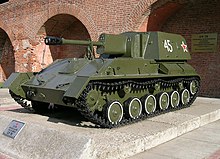
Assault guns were primarily developed duringWorld War IIby the forces ofNazi Germanyand theSoviet Union.Early in the war, the Germans began to create makeshift assault guns by mounting theirinfantry support weaponson the bed of atruckor on obsoletetankswith the turret removed. Later in the war, both the Germans and the Soviets introduced fullyarmouredpurpose-built assault guns into their arsenals.
Early on, the Soviets built theKV-2,a variant of theKV-1heavy tank with a short-barreled152 mm howitzermounted in an oversized turret. This was not a success in battle, and was replaced with a very successful series of turretless assault guns: theSU-76,SU-122,and the heavySU-152,which were followed by theISU-122andISU-152on the newISheavy tankchassis.

The primary German assault gun was theSturmgeschütz III(StuG III). At about the same time (March 1942) as the howitzer-like KwK 37 gun was dropped from the Panzer IV's use, itsSturmkanoneequivalent in the StuG III up to that time, was likewise replaced with a longer-barreled, high-velocity dual-purpose75 mm gunthat had also been derived from the successfulPaK 40anti-tank towed artillery piece. The Germans also built a number of other fully armoured turretless assault guns, including theStuG IV,StuIG 33B,BrummbärandSturmtiger.This last one was a very heavy vehicle, and was built only in small quantities.
Battalionsof assault guns, usually StuG IIIs, commonly replaced the intendedpanzerbattalion in the Germanpanzergrenadierdivisionsdue to the chronic shortage of tanks, and were sometimes used as makeshifts even in thepanzer divisions.[11]Independent battalions were also deployed as "stiffeners" forinfantrydivisions, and the StuG III'santi-tankcapabilities bolstered dwindling tank numbers on the Eastern and Western fronts.
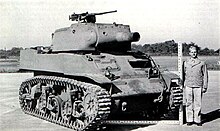
US and UK forces also deployed vehicles designed for a close support role, but these were conventional tanks whose only significant modification was the replacement of the main gun with a howitzer. Two versions of the AmericanSherman tankwere armed with theM4 105 mm howitzer,the M4(105) and the M4A3(105); these were designated assault guns in US usage of the term. TheM8 Scott,based on the chassis of theM5 Stuartlight tank, was also an assault cannon and carried a75 mm short howitzer.TheChurchill,Centaur andCromwelltanks were all produced in versions armed with95 mm howitzers:the Churchill Mark V and Mark VIII, the Centaur Mark IV and the Cromwell Mark VI. Earlier British tanks, such as theCrusader cruiser tankand theMatilda II Infantry tankwere produced in versions armed with the3-inch howitzer;the first versions of the Churchill tank also had this gun in a hull mounting. Americantank destroyerunits were often used in the assault gun role for infantry support.
The AVRE version of the Churchill tank was armed with aspigot mortarthat fired a 40 lb (18 kg)HE-filled projectile (nicknamed theFlying Dustbin) 150 yards (140 m). Its task was to attack fortified positions such asbunkersat close range (seeHobart's Funnies).
Since World War II
[edit]In the post-World War II era, most vehicles fitting into an "assault gun" category were developed as a light-weight, air-deployable, direct fire combat vehicles for use with airborne troops. Those weapons were either based onlight utility vehiclesor smalltracked vehiclesand the airborne troops thus always fought at a distinct disadvantage in terms of heavy weapons. The Soviet Union and the United States were the most attracted to the idea of providing this capability to traditionally light airborne forces. Their answers to the problem were similar, with the United States developing theM56 Scorpionand the Soviet Union developing theASU-57,both essentially airdroppable light anti-tank guns.

The Soviets went on to develop an improved airdroppable assault gun, theASU-85,which served through the 1980s, while theirSU-100remained in service with Communist countries, including Vietnam and Cuba, years after World War II. The US M56 and another armoured vehicle, theM50 Ontos,were to be the last of the more traditional assault guns in US service. Improvised arrangements such asM113 personnel carrierswith recoilless rifles were quickly replaced by missile carrier vehicles in the anti-tank role.
The only vehicle with the qualities of an assault gun to be fielded after the removal of the M50 and M56 from service within the US military was theM551 Sheridan.The Sheridan's gun was a low-velocity weapon suitable in the assault role, but with the addition of theShillelagh missilecould double in the anti-tank role as well. The Sheridan, however, was not developed as an assault gun but as a light reconnaissance vehicle.

Currently, there appears to be a move toward wheeled vehicles fitting a "tank destroyer" or "assault gun" role, such as theM1128 mobile gun systemof theUnited States Army,theB1 Centaurowheeled tank destroyer of theItalianandSpanish Armies,the Chinese anti-tank gunPTL-02andZBL08 assault gun,and the FrenchAMX-10 RCheavy armoured car. While these vehicles might be useful in a direct fire role, none were developed with this specifically in mind, reminiscent of the use of tank destroyers by the US military in the assault gun role during World War II.
Assault guns per nation
[edit]Germany
[edit]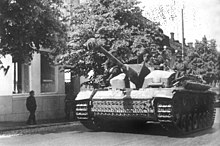
- 1940 –Sturmgeschütz III
- 1940 –Sturmpanzer I Bison
- 1941 –Sturmpanzer II
- 1942 –Sturmpanzer III
- 1942 –Sturm-Infanteriegeschütz 33B
- 1943 –Sturmhaubitze 42
- 1943 –Sturmgeschütz IV
- 1943 –Sturmpanzer IV Stupa
- 1943 –Sturmpanzer 38(t) Grille Ausf. H
- 1944 –Sturmpanzer 38(t) Grille Ausf. K
- 1944 –Sturmpanzer VI Sturmtiger
Hungary
[edit]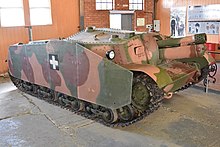
- 1943 –43M Zrínyi II
- 1944 –44M Zrínyi I
Italy
[edit]
- 1942 –Semovente da 47/32
- 1942 –Semovente da 75/18 M41
- 1943 –Semovente da 75/32 M41
- 1943 –Semovente da 75/34 M42
- 1943 –Semovente da 105/25 M43
- 1944 –Semovente da 75/34 M43
- 1944 –Semovente da 75/46 M43
- 1991 –B1 Centauro
- 2018 –B2 Centauro
Japan
[edit]
- 1942 –Type 1 Ho-Ni II
- 1944 –Type 4 Ho-Ro
- 1944 –Type 4 Ho-To
- 2016 –Type 16 maneuver combat vehicle
South Africa
[edit]
- 1962 –Eland 90
- 1987 –Rooikat 76
- 1994 –Rooikat 105
Soviet Union
[edit]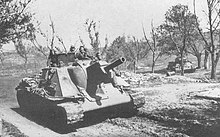
- 1931 –SU-1
- 1934 –SU-5
- 1935 –SU-6
- 1935 –AT-1
- 1939 –KV-2
- 1941 –SU-76P
- 1942 –SU-76
- 1942 –SU-122
- 1943 –SU-85
- 1943 –SU-152
- 1943 –ISU-152
- 1944 –ISU-122
- 1944 –SU-100
- 1945 –Object 704
- 1951 –ASU-57
- 1955 –SU-122-54
- 1956 –Object 268
- 1958 –ASU-85
Sweden
[edit]
- 1943 –Stormpjäs fm/43
- 1944 –Stormpjäs fm/43-44
- 1944 –Stormartillerivagn m/43
- 1953 –Infanterikanonvagn 72
- 1957 –Infanterikanonvagn 73
- 1957 –Infanterikanonvagn 102
- 1957 –Infanterikanonvagn 103
- 1976 –Infanterikanonvagn 91
- 1994 –Stridsfordon 90105
- 1998 –Stridsfordon 90120
USA
[edit]
- 1942 –M8 Scott
- 1944 –M4 Sherman 105
- 1953 –M56 Scorpion
- 1969 –M551 Sheridan
- 1992 –M8 AGS
- 2002 –M1128 Stryker
- 2021 –XM1302 MPF
- 2022 –M10 Booker
See also
[edit]References
[edit]- ^abcBlennemann, Dirk (2003).Hitler's Army: The Evolution And Structure Of German Forces 1933-1945.Boston: Da Capo Press. pp. 66–63.ISBN978-0306812606.
- ^Bull, Stephen (2004).Encyclopedia of Military Technology and Innovation(2004 ed.). Greenwood Publishing Group. p. 229.ISBN978-1573565578.
- ^Bradford, James (2006).International Encyclopedia of Military History(2006 ed.). Routledge Books. pp. 123–124.ISBN978-0415936613.
- ^abcdGudmundsson, Bruce (2004).On Armor.Westport, Connecticut: Prager Books. pp. 114–126.ISBN978-0812216202.
- ^Tucker-Jones, Anthony (2016).German Assault Guns and Tank Destroyers 1940 - 1945: Rare Photographs from Wartime Archives.Barnsley, South Yorkshire: Pen & Sword Books, Ltd. p. 114.ISBN978-1473845992.
- ^abLevine, Mark (2000).D-Day to Berlin: The Northwest Europe Campaign, 1944-45.Mechanicsburg: Stackpole Books. pp. 21–22.ISBN978-0811733861.
- ^Gabel, Christopher; Estes, Kenneth (August 1999). Hoffman, George; Starry, Donn (eds.).Camp Colt to Desert Storm: The History of U.S. Armored Forces.Le xing ton, Kentucky: University Press of Kentucky. pp. 149–156, 479–481.ISBN978-0813121307.
- ^abUnderhill, Garrett (November–December 1972). "The Story Of Soviet Armor: Assault Guns And Self-Propelled Artillery".Armor.Fort Knox, Kentucky: US Army Armor Center: 28–38.
- ^sp15 (Sep 29, 2018)."Swedish tanks: Ikv 91 revisited".From the swedish archives.WordPress.Retrieved2022-05-16.
{{cite web}}:CS1 maint: numeric names: authors list (link) - ^Warford, James (July–September 2016). "Armored Vehicle Development Behind The Curtain: The Secret Life Of The Soviet SU-122-54 Assault Gun".Armor.Fort Knox, Kentucky: US Army Armor Center: 12–14.
- ^Thomas L. Jentz (1996): Panzertruppen: The Complete Guide to the Creation & Combat Employment of Germany's Tank Force, vol.2, 1943-1945, p.68

